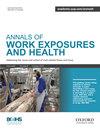35a - Supporting women in mining: diversity and inclusion
IF 1.8
4区 医学
Q3 PUBLIC, ENVIRONMENTAL & OCCUPATIONAL HEALTH
引用次数: 0
Abstract
Traditionally, the mining sector has not been viewed as a leader in effectively managing diversity and inclusion. While numbers have improved, women continue to be underrepresented at every level within mining companies. Currently, the mining sector is committed to increasing diversity and improving inclusion. Globally, mining has set gender-based targets for the sector. They are actively investing in the success of women in mining and jurisdictions and organizations are tracking and reporting on diversity and inclusion performance. Mining organizations are engaged in improving inclusion-related efforts that promote the sense of belonging for workers. Why is diversity and inclusion important to mining? Diversity and inclusion promote creativity and strategic resilience. This is important as mining companies manage the complex challenges associated with community, environmental, social (including health and safety), and technical aspects of their industry. With increasing numbers of women in surface and underground mining and processing operations, a strategy is needed to better support these workers including their health, safety, and well-being, including reproductive health. This presentation will review the history of women in mining, challenges for women to access decent work in mining, suggestions that support recruiting and retaining women in the sector, and the path forward towards gender equality in mining. The importance of advancing equal employment opportunity and human rights in the workplace will be highlighted, along with the need for additional research to support women’s reproductive health and mitigate the risk of adverse reproductive outcomes. The next presentation will cover in more depth this latter topic.35a - 支持采矿业妇女:多样性和包容性
传统上,采矿业并不被视为有效管理多样性和包容性的领导者。虽然妇女人数有所改善,但在矿业公司的各个层面,妇女的代表性仍然不足。目前,采矿业致力于提高多样性和包容性。在全球范围内,矿业部门已经制定了基于性别的目标。他们积极投资于妇女在采矿业的成功,各辖区和组织正在跟踪和报告多样性和包容性方面的表现。矿业组织正在改进与包容性相关的工作,以增强工人的归属感。为什么多样性和包容性对采矿业很重要?多样性和包容性促进创造力和战略应变能力。这对于矿业公司管理与其行业相关的社区、环境、社会(包括健康与安全)和技术方面的复杂挑战非常重要。随着露天和地下采矿及选矿作业中的女性人数不断增加,需要制定一项战略来更好地支持这些工人,包括她们的健康、安全和福利,包括生殖健康。本讲座将回顾妇女参与采矿业的历史、妇女在采矿业获得体面工作所面临的挑战、支持该行业招聘和留住妇女的建议,以及实现采矿业性别平等的前进道路。还将强调在工作场所促进平等就业机会和人权的重要性,以及开展更多研究以支持妇女生殖健康和降低不良生殖后果风险的必要性。下一次发言将更深入地讨论后一个主题。
本文章由计算机程序翻译,如有差异,请以英文原文为准。
求助全文
约1分钟内获得全文
求助全文
来源期刊

Annals Of Work Exposures and Health
Medicine-Public Health, Environmental and Occupational Health
CiteScore
4.60
自引率
19.20%
发文量
79
期刊介绍:
About the Journal
Annals of Work Exposures and Health is dedicated to presenting advances in exposure science supporting the recognition, quantification, and control of exposures at work, and epidemiological studies on their effects on human health and well-being. A key question we apply to submission is, "Is this paper going to help readers better understand, quantify, and control conditions at work that adversely or positively affect health and well-being?"
We are interested in high quality scientific research addressing:
the quantification of work exposures, including chemical, biological, physical, biomechanical, and psychosocial, and the elements of work organization giving rise to such exposures;
the relationship between these exposures and the acute and chronic health consequences for those exposed and their families and communities;
populations at special risk of work-related exposures including women, under-represented minorities, immigrants, and other vulnerable groups such as temporary, contingent and informal sector workers;
the effectiveness of interventions addressing exposure and risk including production technologies, work process engineering, and personal protective systems;
policies and management approaches to reduce risk and improve health and well-being among workers, their families or communities;
methodologies and mechanisms that underlie the quantification and/or control of exposure and risk.
There is heavy pressure on space in the journal, and the above interests mean that we do not usually publish papers that simply report local conditions without generalizable results. We are also unlikely to publish reports on human health and well-being without information on the work exposure characteristics giving rise to the effects. We particularly welcome contributions from scientists based in, or addressing conditions in, developing economies that fall within the above scope.
 求助内容:
求助内容: 应助结果提醒方式:
应助结果提醒方式:


